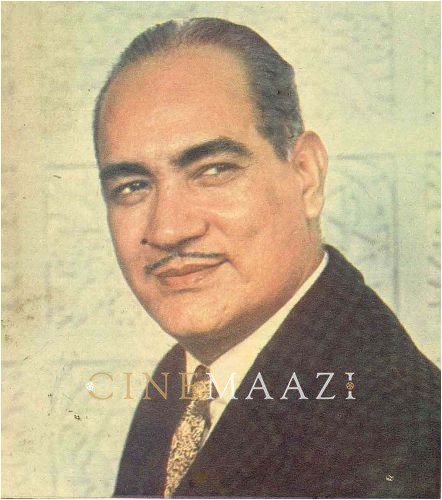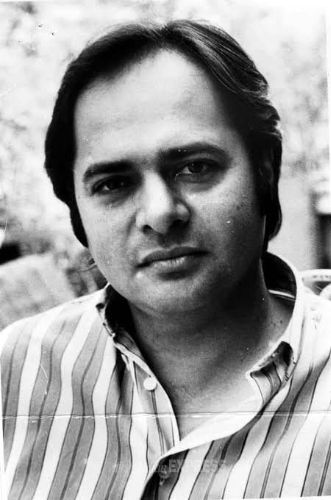O P Nayyar

Subscribe to read full article
This section is for paid subscribers only. Our subscription is only $37/- for one full year.
You get unlimited access to all paid section and features on the website with this subscription.
Not ready for a full subscription?
You can access this article for $2 , and have it saved to your account for one year.
- Real Name: Omkar Prasad Nayyar
- Born: 16 January, 1926 (Lahore, Punjab, British India)
- Died: 28 January, 2007 (Bombay)
- Primary Cinema: Hindi
- Parents: Madan Gopal Nayyar
- Spouse: Saroj Mohini Nayyar
- Children: Sonia, Annapurna, Laxmi, Ashish
Unofficially titled Asia’s Rhythm King, composer and music director O. P. Nayyar was one of the premier composers of Hindi film music’s golden age. Using unusual and vibrant rhythms in his film music, especially in the 1950s and 1960s, he is also known for his long collaboration with the legendary playback singer Asha Bhosle, which produced umpteen hit numbers. His biggest hit, Mera naam chin chin choo was in Howrah Bridge (1958) and later became a popular dance tune. He created some of his most memorable work in films like Aar Paar (1954), Mr & Mrs 55 (1955), Chhoo Mantar (1956), CID (1956), Naya Daur (1957) for which he won his only Filmfare Award for Best Music Director, Tumsa Nahin Dekha (1957), Howrah Bridge (1958), and Phagun (1958). He continued composing down to the more recent Bin Maa Ke Bachche (1980), Nishchay (1992) and Zid (1994). Nayyar worked extensively with singers Geeta Dutt and Mohammed Rafi as well but not with Lata Mangeshkar, whose voice, he believed, was inappropriate for his songs.
Born on January 16, 1926 in Lahore in pre-Partition India, O P Nayyar underwent musical training at a young age and made his professional debut at age 11, playing the piano on All-India Radio. He was only seventeen when he composed his first songs, which were later given by a friend of his to Dalsukh Pancholi. Soon he received an invitation to come to Bombay. His debut as music director followed with Dalsukh Pancholi's Aasmaan (1952). The soundtrack contained the Geeta Dutt sung gem Dekho jadoo bhare nain. The prelude to the song Pom pom pom baaja bole was later used by Binaca Geetmala. A slump caused by commercial flops saw him considering quitting cinema to teach music; however, his fortunes revived with Guru Dutt's Aar Paar (1954). It was his first box-office hit. He had worked with Dutt the first time in Baaz (1953), though that film had proved to be unsuccessful, despite containing some stellar work from Nayyar in songs like Aye dil aye deewane. He would go on to collaborate with Dutt in Mr. and Mrs. 55 (1955) and the thumping hit C.I.D. (1956). In the early years he worked with Shamshad Begum, Geeta Dutt and Mohammed Rafi, and with Asha Bhosle from C.I.D. onwards. His greatest success came jointly with Asha Bhosle, who he is said to have discovered. He moulded for Bhosle a range of bold and modern songs that were strongly rhythmic and upbeat. They worked together for nearly 60 films in all, with some of their finest collaborations seen in Naya Daur (1957), Tumsa Nahin Dekha (1957), Sone Ki Chidiya (1958), and Howrah Bridge (1958). Their immense success established Bhosle as a rival to the reigning melody queen of Hindi film music - Lata Mangeshkar and who was also her sister, even as it cemented Nayyar as the highest-paid composer in Hindi film music. Their partnership ended on a sour note in 1974. Though Nayyar went on to work with singers like Mahendra Kapoor, Dilraj Kaur, Alka Yagnik, Krishna Kale, the fierceness of the creative spark ignited with Asha was never achieved again. After a brief slump in the late 50s, Nayyar came back with a bang in the 60s with unforgettable soundtracks like Ek Musafir Ek Hasina (1962), Phir Wohi Dil Laya Hoon (1963), Kashmir Ki Kali (1964), Mere Sanam (1965), Baharen Phir Bhi Ayegi (1966), C.I.D 909 (1967), and Kismat (1968). He also composed for one Telugu film Neerajanam (1989). He retired from film music altogether following Zid (1994), still remaining a recognised faced due to his appearances on television.
A maestro at combining unusual rhythm patterns, O P Nayyar’s melodies defied convention. He composed bold and rare tunes, which became a huge draw for audiences, leading to his name being printed above those of the film’s stars, in some cases. Emanating zing and energy, he had the gift of blending Punjabi spirit with western music creating foot-tapping rhythms. He created a range of rhythm-based hits in songs like Ye lo main haari piya (Aar Paar), Aaiye meherban baithiye jaanejaa (Howrah Bridge), Dil par hua aisa jaadoo (Mr & Mrs 55), Huzoor-e-Walaah (Yeh Raat Phir Na Aayegi) and Ek baar muskura do (Ek Baar Muskura Do, 1972). Despite his repulation as a rhythm-based composer, he also composed a plethora of songs with classical roots as well as some bhajans. He never had any formal musical training, nor could he read notations.
Blessed with the gift for imbuing his songs with an earthiness, he brought out diverse emotions such as romance, guilt or sadness with the proper emotion, pitch and tenor as seen in the sadness-filled Chain se humko kabhi (Pran Jaye Par Vachan Na Jaye, 1974) and Tukde hain mere dil ke (Mere Sanam) or the sprightly Suno suno Miss Chatterji (Baharein Phir Bhi Aayengi) and Ae dil hai mushkil jeena yahan (CID). A creative genius unrestrained by rules, as a composer he was way ahead of his time, an original in a sea of copycats. His experiments were note-worthy, especially his eschewing percussion instruments and drums to create rhythmic patterns from unusual sources such as the sound of clapping or the click of horse hooves - the tonga beat is now permanently linked to him. His unusual and catchy innovations in percussion became his trademark. These elements can be identified in several songs whether Ye chand sa raushan chehra (Kashmir Ki Kali) or Maang ke saath tumhara (Naya Daur). His use of the Spanish castanets is seen in Aayiye Meherbaan (Howrah Bridge) at the point when Asha sings ‘Ishq ke imtihan…’ and in Lakhon hain nigah mein (Phir Wohi Dil Laya Hoon), where it adds an undeniable zest.
Nayyar changed the rules of Hindi film songs, in several ways. He took the sarangi out of the confines of the kotha, using it in songs like Aana hai to aa (Naya Daur, 1957) and Bekasi hadd se jab guzar jaye (Kalpana, 1960) and from its connotations of sadness to transform it into an upbeat musical instrument. Similarly, he used the santoor in a fast-paced, insistent fashion as seen in Jaayiye aap kahaan jaayenge (Mere Sanam).
He enjoyed a fruitful creative partnership with Majrooh Sultanpuri who penned 127 songs for him, with S H Bihari who wrote 94 songs, with Sahir Ludhianvi in his early years. He also worked with lyricists like Qamar Jalalabadi, Jan Nisar Akhtar and Ahmed Wasi. His oeuvre also featured several popular songs picturised on comedians like Johnny Walker in the iconic Ae dil hai mushkil jeena yahan from C.I.D.
Known for his showmanship, he remained a strict disciplinarian who expected nothing but the best from his song writers and singers, including Kishore Kumar whom Nayyar once famously ousted from the recording studio as Kumar was not rendering the devotional song, Man mora bawra to the required level of expectation. Or the time he had Rafi ousted from the studio when he reported late for a recording - and didn’t relent for many years. His wife Saroj Mohini Nayyar wrote the lyrics for Preetam aan milo, a popular song by C H Atma.
He did not suffer fools gladly and could spot a fraudster with ease. A loner who defied society’s conventions, he left home at the age of 60-plus to live and wander alone. His earlier passion for music was matched by his interest in homeopathy and astrology. Nayyar passed away on January 28, 2007, less than two weeks past his 81st birthday. He remains a blessing for Indian film music, leaving behind a treasure trove of immortal melodies. A commemorative stamp in his honour was issued by India Post on 3 May, 2013.
References
Premchand, Manek. Yesterday's Melodies Today's Memories. Notion Press, 2018.






.jpg)



